In: sculpture

Dimitri Tsykalov | MEAT | 2007 – 2008
July 28, 2023Dimitri Tsykalov | MEAT | 2007 – 2008
It’s not a new idea that firearms make acts of violence ‘too easy’, almost ‘antiseptic’, as they minimize the necessary physical contact intrinsic to other acts of brutality. This is an idea that’s been raised about technology since we began using it to kill each other.
(At the risk of seeming flippant, I must also inject a quote that came to mind when I first encountered images of Tsykalov’s MEAT : Invariably, the first question asked about a new technology is, “Can this make killing less of a hassle?” The second being, “Can I have sex with it?”…)
The implicit ‘removal’ or ‘remoteness’ (I’m reminded of the ski pole scene from Timothy Findley’s The Wars, for example, where the firearm and act of murder almost seem separate from the character himself) makes it almost a ‘trivial’ or ‘throwaway’ action to fire a gun.
Dimitri Tsykalov’s MEAT works offer a counter to that, in a grotesque manner that is excessive : I’ve debated writing about Tsykalov’s ‘armaments’ for a while, unsure if they’re too flippant, or too horrifying, or a combination of both that is as unpalatable as gripping cold flesh while your hands are stained and overrun with effluvia…
These works don’t pretend to an aesthetic distance (like in Serrano’s work, or some other artists I’ve talked about here who – like myself, when I worked with fat, bone and meat for over two decades – are interested in creating inappropriately beautiful artwork) : I feel that Tsykalov takes pleasure in our revulsion and wants to evoke it from us, and considering what he’s ‘butchering’ the meat, flesh and bone into, this is not inappropriate. There’s a swagger here, a bravado that intends to make us ill. Meat and guns are, after all, metaphors for penises or toxic masculinity, and Tsykalov alludes to that (even with the titles that reference specific guns).
Tsykalov, in creating work that intersects with brutality and our capacity for it, as a species, has taken an opposing artistic path to someone like Ralph Ziman with The Ghosts Project (a past Curator’s Pick you can see here).
Tsykalov’s own words : “In these pictures I recognize the murderers within me, I recognize love and death within me; in these pictures I recognize my flesh as the cannon fodder it is and will be for the rest of my life. In contrast the secondary meat in these shots – the one that rots and that kills, the animal meat that is used to create the fleshy weapons – seems unscathed, sanguine and elegiac. It is incredibly alive, it is cannon flesh and we are already mortal.”
Dimitri Tsykalov was born in Moscow (1963) where he attended Polygraphic Institute of Moscow (1982-1988). He currently lives and works in Paris.
More of his work can be seen here.
~ Bart Gazzola
Read More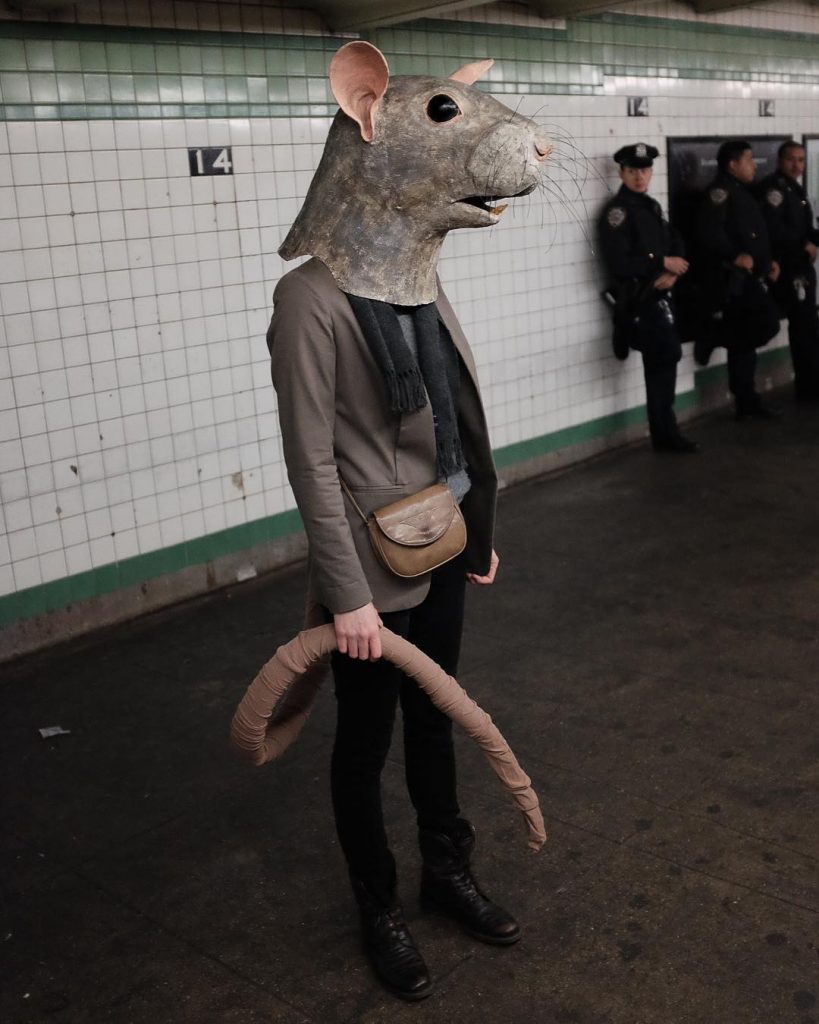
Liz Sexton
June 9, 2023Liz Sexton
“You aren’t a tiger. You’re a rat. No, that’s an insult to a noble and numerous species of rodent. You’re less than a rat.”
(Neil Gaiman, Anansi Boys)
When considering Liz Sexton’s Rat mask (which the artist created for Halloween and was documented in Brooklyn, New York, several years ago, amidst the visceral urban subway) and the stylish, self possessed Ratman I am initially reminded of the Rats (note the capitalization) and the Rat Speakers from the book Neverwhere.
Humour and horror (both heavily flavoured with the absurd in a delightfully performative manner) inform Sexton’s works. That’s one of the reasons why I included the images with her cat among those I’m sharing, as the cat’s unimpressed languor challenge the stoic existential nature of her ‘players’ (sometimes Sexton is the one donning the masks, other times not) that become something so much more in her masks, especially as they trod the public sphere. The Ravens (yes, I feel the need to formalize the characters in these scenes) on the subway may be harbingers of doom (if we’ve learned nothing from Edgar Allen Poe, don’t ask a Raven a question you don’t want answered, ahem) or simply out for the evening, on the way to meet fellow feathered friends : please don’t bother them, as a group of ravens IS called an ‘Unkindness.’
Other characters are engaged in equally banal every day activities, while others gaze directly back at us in a challenging manner, and others are captured in quiet moments of introspection, where we seem to be intruding on private moments.
Whether these are ‘disguises’ or new personas, I leave to your own discretion in any conclusion you make.
The words of the artist : “Most everything I create is meant to be interacted with, whether masks, puppets, or simply objects—they’re all intended to be worn, held, or touched….With the wearer concealed under a larger-than-life mask, it becomes as much a human with an animal head as an animal with a human body—a very interesting thing to interact with.
I often work on threatened species, particularly sea creatures, and photograph the animal masks worn in very human habits, highlighting the displacement that many creatures are currently experiencing. I also work on more common animals that we might share our surroundings with but don’t necessarily notice or engage with. Presented on a human scale, they share our world, becoming visible members of our communities.“ (from here)
In this light, I am also reminded of the moment – in Welland’s rust belt wonderland – when I met up with a fox late at night. Their unflinching gaze let me know who was the interloper, and it wasn’t them….
Liz Sexton has lived and worked in Paris, Berlin, and New York, and has recently returned to her Midwest roots, calling Saint Paul, Minnesota home. For now. Experienced in a wide range of mediums, these days she favors paper mâché for its versatility and accessibility. She enjoys creating sculptural objects, often inspired by the natural world.
Liz Sexton’s solo exhibition Out of Water is on view at the Minnesota Marine Art Museum May 6 – September 3, 2023.
Much more of her work can be enjoyed at her site here and her IG can be seen here.
~ Bart Gazzola
Read More
Takayo Kiyota | Tama-Chan
April 6, 2023Takayo Kiyota | Tama-Chan
“That’s what you get for being food.”
― Margaret Atwood, The Edible Woman
Takayo Kiyota (also known as Tama-Chan) produces what can only be described as sushi art: some are playful, some are slightly more unsettling and others offer an interesting opportunity for dialogue about our relationship to food and larger assumptions around aesthetics.
In this artwork, Kiyota – who has interpreted famous works such as Edvard Munch’s The Scream (1893) or Vermeer’s Girl With A Pearl Earring | Meisje met de parel (1665) – re-imagines a painting that is well known but often misconstrued, sometimes in a bawdy manner.
Gabrielle d’Estrées et une de ses soeurs (Gabrielle d’Estrées and one of her sisters) was painted by an unknown artist (perhaps from the Fountainbleau School) around 1594. It can seen in the Louvre, in Paris: “The painting portrays Gabrielle d’Estrées, mistress of King Henry IV of France, sitting nude in a bath, holding a ring. Her sister Julienne-Hyppolite-Joséphine sits nude beside her and pinches d’Estrées’ right nipple.” More about this painting can be seen here.
Years ago, I experienced an audio environment / installation by Anitra Hamilton: the bare gallery space was inundated by two conflicting yet connected audible narratives. One section of the gallery was suffused by a recording of a Sotheby’s auction of artworks. The other was a cattle auction, with ‘prize’ animals going to the highest bidder. In a response to that exhibition I made some uncomfortable analogies to what we consume, how we value it, and the conversations around these things that ‘feed’ us.
Tama-chan (Takayo Kiyota) was born in Shinjuku, Tokyo. After graduating from the Setsu Mode Seminar she started to work in advertisement, magazines, and books as a freelance illustrator. Since 2005, she has called herself the sushi roll artist “Tama-chan.” Through workshops she has been introducing the importance of food culture, food education, as well as the joy of making things with her maki-sushi. In 2013, she won the second prize on “the longest scream in the world” sponsored by Innovation Norway. In 2014, Little More Co. published Smiling Sushi Roll, the first anthology of her work.
You can see more of these delicate and temporary artworks on IG : @smilingsushiroll39
~ Bart Gazzola
Read More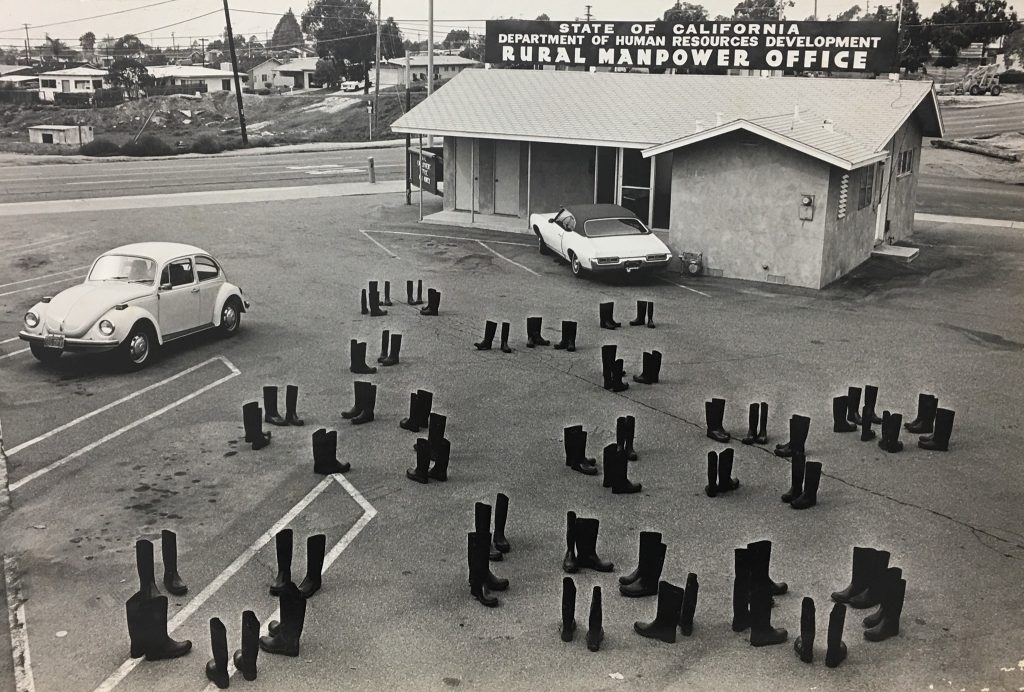
Eleanor Antin | 100 Boots, 1971-73
October 28, 2022Eleanor Antin | 100 Boots, 1971-73
“For month after month after month, her five-score empty rubber boots had to be carted across the country, set up in various evocative spots, and then photographed before someone could come along and chase Antin away…at the time, the empty boots would have had immediate resonance as a reference to the Vietnam War, and to the boot-wearers who would never come home.” (Blake Gopnik)
Eleanor Antin is an artist who has not, in my opinion, received the credit she merits for her performative installations and photographs that have a cinematic quality. At the risk of being flippant, if Gopnik, Camille Paglia and I myself all agree as to her importance, we surely can’t be wrong. Antin has been making work since the 1960s, and her art often intersects with politics in both overt and covert ways.
From Paglia’s Glittering Images: A Journey through Art from Egypt to Star Wars: ‘As a work of Conceptual art, 100 Boots consisted of temporary on-site sculptural installations documented by photographs (taken by Philip Steinmetz), which were sent uninvited to a distant, dispersed audience. The formal, squadron-like patterns assumed by the boots parody the frigid geometries then being made by male Minimalist sculptors. In their outdoor placement, the boots evoke traditional landscape painting as well as the new genre of land art, which was just emerging from Minimalism. Antin strategically varied the look of the cards so that “seductively beautiful” images were not the rule. Most of them have a bleak desolation reminiscent of existential European art films. Indeed, Antin saw the work as “a movie composed of still photos”.’
Over her career, Antin ‘has utilized a staggering range of styles, media, and materials, and her work has combined theater, dance, literature, drawing, painting, sculpture, crafts, photography, video, and architecture. “All artworks are conceptual machines,” she said. And again: “All art exists in the mind.” Antin deeply influenced the emergence of both performance art and Conceptual photography.’
For myself, these images are about the insidious nature of loss, especially as it pertains to those who have died during the pandemic. Empty boots that take on the nature of ghosts that appear in any place at any time, a simple – almost banal, like a rubber boot – fact of absence that hits you like a hammer to the chest and requires you to sit down to consider it….
Eleanor Antin was a previously featured Artist You Need To Know, in AIH Studios’ continuing series. That can be enjoyed here.
More works from this series can be seen here.
~ Bart Gazzola
Read More
Asya Kozina | Baroque Paper Wigs, 2016
October 14, 2022Asya Kozina | Baroque Paper Wigs, 2016
Historical wigs always fascinated me, especially the Baroque era. This is art for art’s sake aesthetics for aesthetics, no practical sense. But they are beautiful. I made a series of wigs. Paper helps to highlight in this case the main form and not be obsessed [with] unnecessary details.
There is something both decadent and timeless about Kozina’s work. The idea of a peformative lens comes into play – as these intricate, hand made (with no digital tools) ‘wigs’ only attain their ultimate beauty when worn by one of Kozina’s models, and the rest of the team comes together (meshing together, perhaps, like the paper in the artist’s constructions) to produce a moment that has as much to do with art historical tropes, as seen in the paintings of Jacques Louis David or Caravaggio, as it does with contemporary couture and fashion. The artifice of the apple, the pale face perfectly dotted with subtle spots of rouge, the winsome look eschewing eye contact in one scene and the feigned precociousness of the model looking directly at us in another all suggest this might be a Jean-Honoré Fragonard (more late Baroque, with a touch of the playfulness of Rococo) except for the stark palette, only broken by the red of the apple.
I think of Fragonard as the old Russian Imperial court often looked to France for its ideal, and there’s a sentiment of the elaborate, exotic Ancien Régime to Kozina’s many works: another act of imitation from an artifice of pretension that was, of course, all about social class and cultural capital.
But Kozina does more than just mimic: several bodies of work – such as the more ballistic Baroque Punk or more erotic Eve – employ the history of fashion as a starting point for contemporary considerations and conversations.
More of her work can be seen on IG at @asya_kozina or at her site.
The photographer for this work is Anastasia Andreeva, with assistance from Dina Kharitonova. The makeup artists are Marina Sysolyatina and Svetlana Dedushkina.
~ Bart Gazzola
Read More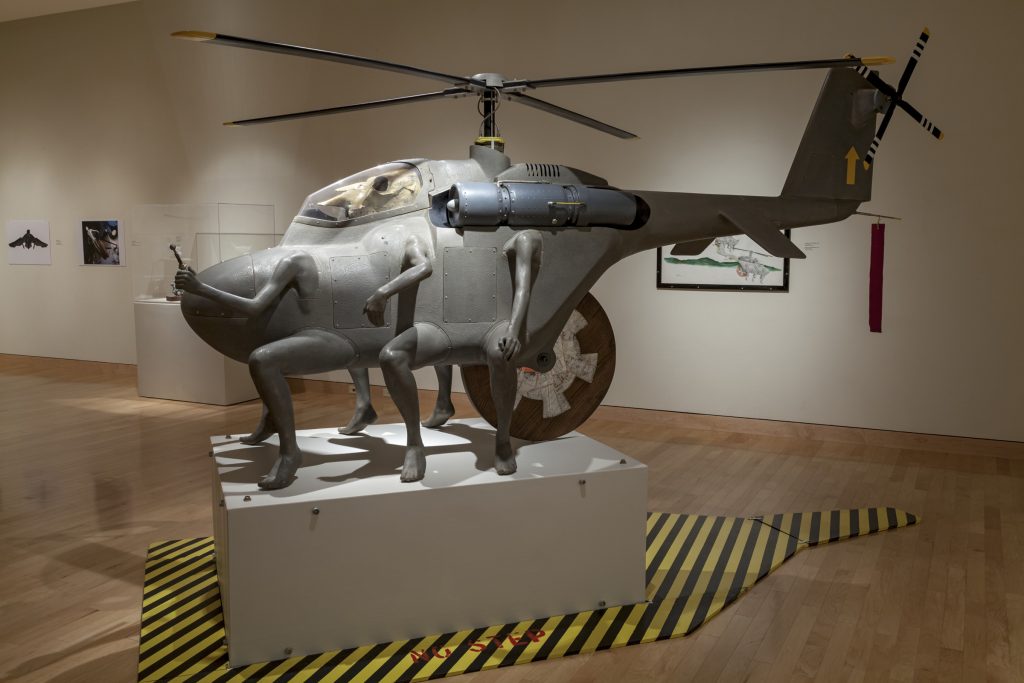
Don Bonham | Twentieth Century Technology Utilized by Third World Mentality, 1993
September 9, 2022Don Bonham | Twentieth Century Technology Utilized by Third World Mentality, 1993
Don Bonham (1940 – 2014) was a sculptor who produced monumental works that intersect with classical ideas about art and also incorporated contemporary references – especially as pertains to industry and technology. His work alternates between humour and a disturbing – yet attractive – aesthetic that reflects back on a larger society, especially in terms of how often any new technological advance is met with the brutal inquiry of whether “Can this make killing less of a hassle?” (Sadly, the second blunt question is, “Can I have sex with it?”). If you think I’m wrong, consider other works by Bonham that would please J.G. Ballard as three dimensional iterations of some of Phoebe Gloeckner‘s illustrations to his texts…or horrify him, edit as you will.
Don’t criticize Bonham’s presumed priapism and the implicit male gaze in his work: an era gets the artwork it merits. His industrial works often openly acknowledged and built upon the fetishization of object that was a continuation of a fetishization of the female body. His works are always seductive and well executed, if initially unsettling.
In his own words: “The gap between human and machine is constantly shrinking. Are we to become more like machines, or machines more like us? The creators of technology have imbued machines with human characteristics, and this tendency is creating a more hospitable environment for their acceptance by society. As an artist I am only enlarging upon this concept.”
Years ago, a fine film critic spoke of how futurism, in cinema, was either a clean, antiseptic space, like an Apple store, or more like Blade Runner, and broken, dirty and more part of an industrial gothic aesthetic. Bonham falls within the latter.
I have been accused of being somewhat ‘subjective’ as a reviewer, often relying upon ‘inappropriate’ sources and considerations when engaging with artwork. This bemuses me, and entertains me even more when I consider that a motivation for featuring a work by Bonham is the rather disrespectful – though typical of the vagaries of institutions that claim to protect and nurture culture – decision by McIntosh Gallery, at the University of Western, to de accession one of his works from their collection. Curator, writer and gallerist Terry Graff has been working against that, and you can see his efforts – and learn more about Bonham and his legacy – at Graff’s social media.
But in looking at Bonham’s sculpture here (and many of his similar works that meld, merge and mash up humanity and machine, with a sense of militarism that is almost inappropriately amusing and intersects with black humour) a Vietnam era anti – war anthem from the 1960s comes to mind. This is fitting, as Bonham came to Canada during the period when many men from the United States were fleeing their country, opposed to the war there. However, “Bonham enlisted in the U.S. Marine Corps and served in an elite Recon unit in Southeast Asia. After six and a half years, he was honorably discharged to enter the University of Oklahoma as an Art History Major. He left university before graduating and worked in Detroit on a Ford assembly line before moving, in 1968, to London, Ontario, where he discovered a dynamic arts community that reinforced his decision to pursue a career as a visual artist.” (from a retrospective of Bonham’s artwork at The Beaverbrook Art Gallery)
The song Sky Pilot by The Animals is as confrontational as Bonham’s Twentieth Century Technology Utilized by Third World Mentality, and for its time was surely controversial: and it’s necessary to include the print below that Bonham produced, of his modified – or realized – helicopters swooping down, mimicking that infamous scene where the ‘righteous’ decimate a village from Francis Ford Coppola’s Apocalypse Now. Death rides a pale horse, a mechanized cyborg that’s surely a descendant of Albert Pinkham Ryder’s The Race Track (Death on a Pale Horse), coming down from the sky….
Regionalism has both defined – and deformed – Canadian art and Canadian art history (and is arguably why Bonham’s work is being so disrespected by the University of Western. Graff is more erudite and informed on this front than I). But regionalism is also the lens through which I respond to the terms of ‘First World’ or ‘Third World’ (cited in the title of this work) which seem as archaic at times as ‘Cold War’ (an epoch I had to explain to students, when I used to teach at a university, and let’s remember that the ‘Second World’ was the Communist Bloc, and the most avowed communist country now is definitely ‘open for business’…).
Bluntly, there are those who have and those who have not, and the tools at hand are used to enhance the former and demean the latter: it is the ‘order of things’, in the era of late capitalist modernism (to quote Jameson) or, as I like to call it, late modernist capitalism. Trinh T. Minh-ha (a Vietnamese – so she has an intimate understanding of the construction of history, as pertains to colonization / imperialism – filmmaker, writer, literary theorist, composer, and professor) famously wrote that “there is a third world in every first world, and vice-versa.” Bonham – and myself, initially – spoke of Vietnam. But you’re more likely to see a third world in your own city, overseen and monitored by a machine not unlike this sculpture (with the excessive militarization of police departments), in the skies over Detroit or Cleveland or Baltimore…or my own site of Niagara, or my previous space of Saskatoon, with tent cities and other ‘undesirables’, too often given harm over help, unlike other more harmful groups that squat, rife with sedition and fascist symbols….
Many thanks to Terry Graff for support, and conversations, that helped define this essay. Much more about Bonham’s life and artwork can be seen at Graff’s social media feed (there is also a petition to make Western reverse their decision here) and Bonham was a past Artist You Need To Know, in AIH Studios’ ongoing series. That can be enjoyed here.
~ Bart Gazzola
Read More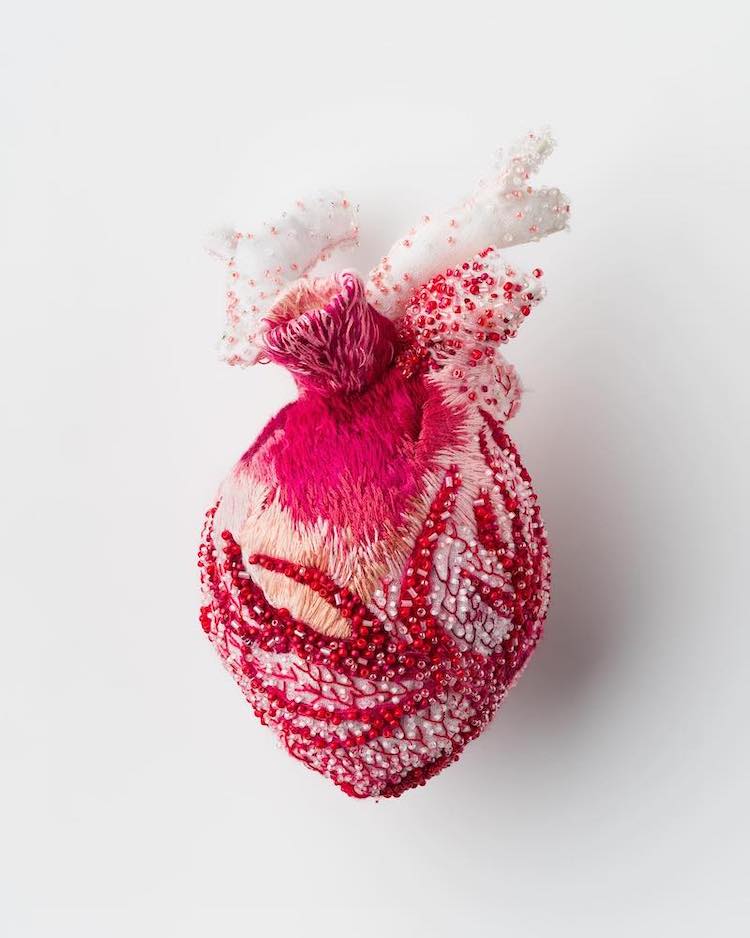
Ema Shin | Hearts of Absent Women
August 26, 2022Ema Shin | Hearts of Absent Women
…as empty as an unremembered heart.
(Mervyn Peake, from his Gormenghast Trilogy)
I was born in Japan and grew up in a traditional Korean Family. My grandfather kept a treasured family tree book for 32 generations, but it only included male descendants’ names, not daughters. In my art, I have always tried to celebrate women and their historical handcrafts. These sculptural hearts are made from embroidery, handwoven tapestry, and papier mâché to recognize and celebrate the silent behind-the-scenes domestic duties of women and represent not only her emotions but serve as offerings or amulets for her protection.
(Ema Shin’s words, from here)
Of late, I’ve been watching the series Motherland: Fort Salem. I’ve a weakness – if you wish to put it that way, but I prefer affinity – for science fiction and fantasy (something I’ve been told, along with my interest in horror, is ‘inappropriate’ for an arts journalist…you know, like how the ‘only real art is painting’, ahem, to cite some of the karaoke modernists I endured on the prairies). The ‘alternate worlds’ are what interest me. When I was consuming William Gibson’s books, I was always more fascinated by the subtle things in his stories, presented as more factual and less chimeric (that the USSR eventually – for all intents and purposes – is run by the ‘criminal’ Kombinant, with the Russian mafia having fully taken over the government, that a religious cult appears that believes god speaks to them through movies – only from a certain era, of course – or that another character makes a living testing logos and brands, as she has an immediate, allergic reaction to any kind of advertising…)
In Motherland, a different world exists than that which we occupy: one where the Salem Accords have forged an uneasy alliance between the Witches of Salem and the United States Government, playing out in contemporary times. Imagine a military industrial complex based upon the magic of witches (or more accurately, the power of women), and – this is the part that is of more interest to me – a society that has formed around that, marking a genesis even before the United States became the United States, that is very matriarchal. Small things stood out to me, about how social ‘norms’ and customs play out very differently in this ‘world’ than in our own, especially around sexuality, power, who is expected to lead and who is expected to follow, and how history – in Salem – is overtly defined by a female gaze, if you will. I say ‘overtly’, as I always remember Martha Langford’s Suspended Conversations: The Afterlife of Memory in Photographic Albums, and those outside the frame who define it, but still are unseen metaphorically as well as literally…..
Ema Shin is a Melbourne based artist who was born and grew up in Niigata, Japan: she studied traditional and contemporary Japanese printmaking in Tokyo and completed a Master of Fine Art Degree in Nagoya. Shin has exhibited widely in Japan, Korea, Australia and elsewhere. Prior to this series, Shin focused on a variety of printmaking techniques and mediums, including Japanese woodblock printing, papier-mâché, embroidery, book making, Urauchi (chine-colle) and collage.
This interest in the physicality of materials continued when, due to motherhood and the pandemic, Shin “began to explore tapestry and embroidery…her red embroidered organs and [three dimensional] human hearts are beautiful to look at, and deeply personal-political in meaning.” (from here)
These are the archival giclée prints of the delicate objects Shin has created as part of her Hearts of Absent Women series (all photographs are by Matthew Stanton), and are an edition of 50.
From her site (which has many of her other fine works, so I encourage you to explore it): “Shin aims to create compositions that express sensitivity for tactile materials, the contemporary application of historical techniques, physical awareness, femininity and sexuality to celebrate women’s lives and bodies.”
Her Instagram is @ema.shin.
~ Bart Gazzola
Read More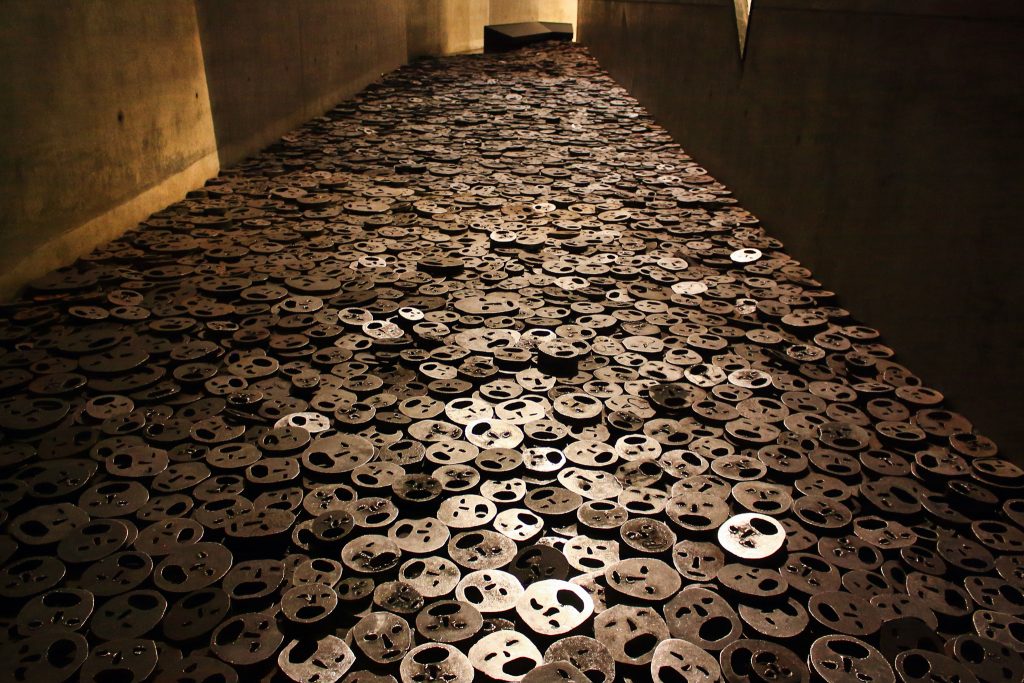
Menashe Kadisman | Shalechet (Fallen Leaves), 1997 – 2001
August 19, 2022Menashe Kadishman | Shalechet (Fallen Leaves), 1997 – 2001
Installation, Jewish Museum, Berlin
When we were young, we wanted our art to change the world. But when Hitler bombed Guernica, did Picasso’s painting have any effect? I thought that maybe some things of mine could do good. My sculptures didn’t change the war in Lebanon. Maybe art is not about changing anything. It’s about telling you reality. (Menashe Kadishman)
I will admit that I rely upon the term ‘contested narratives’ a bit too much: but when confronted with Kadishman’s installation, where his own personal history (as the child of two committed Zionists, in the early twentieth century) and larger tropes intersect, contradict and in some ways twist and transform in a manner that is more apropos to a fictional story than our expectations of ‘reality’, I feel I have no recourse.
Kadishman’s installation is “primarily associated with the Shoah (the Holocaust) [but] it holds a universal message against violence and human suffering. Kadishman himself notes that the work can relate to different tragedies such as World War I and Hiroshima. In part, Shalechet derives its meaning from the context of its presentation. For example, it took on a new meaning in 2018, when it was exhibited at the Memorial Hall dedicated to the victims of the Nanjing massacre in China.” (I include a link as this horror is lesser known, in the cacophony of savagery that is human history, like the many – repetitive, interchangeable, eternal – ‘faces’ silently wailing on the floor of Shalechet, growing old and rusting and still unheard….)
Read more of Gazzola’s response to this work here.
Read More
War Map Dress Trilogy | Carolyn Wren, 2003-2004
June 30, 2022Carolyn Wren | War Map Dress Trilogy, 2003-2004
(lino blocks, hand-printed on Dupont silk, thread, zippers, mannequins, model airplanes, black paint)
I encountered these towering figures during Wren’s retrospective exhibition Task At Hand at the now shuttered Rodman Hall Art Centre several years ago. Standing in the large back gallery space, the three female figures dominated the room, with the flow of their dresses spilling out from them, pooling around them on the gallery floor.
Visiting this show numerous times, I found that different ideas came to the fore with different interactions, from initial wonder to later, more critical consideration. When an artist / writer friend, Anna Szaflarski, visiting Niagara, came with me on one occasion, she saw the works in a very different light than I had, initially. Unsurprising, really, as when Szaflarski and I first met, it was around her exhibition at NAC about the historical detritus – or lack thereof – of General Motors’ legacy in St. Catharines, and I believe we connected over an irreverent honesty about history, the region, and the intersecting if conflicting stories of the place we both grew up in….
My reading had been informed by Wren’s own words, which are as follows: The ingenuity of Christopher Clayton Hutton’s invention of silk maps for the British Royal Air Force during World War II enabled pilots to use lightweight and durable maps to help them reach safety in times of crisis, and inspired women to make dresses out of the silk maps as their men returned home. The maps used by Wren in the dresses were made in Europe by the Canadian government and shipped to Canada for families to follow the movements of their loved ones fighting in the war. Alluding to multiple layers of symbolism of the landscape in relation to the body, and reflecting on war and the politics of Feminism (viewpoint, memory, and identity), The War Map Dress Trilogy is more about history, location, distances, than it is about terrain.
I talk a lot about ‘contested narratives’: but this story, this Curator’s Pick is very much about that. Szaflarski – a former student of Wren’s, as Caroline taught in Niagara for some time, and helped shape a few generations of artists and art appreciators – upon seeing the exhibition, and these ‘women’, spoke more in a manner reminiscent of Barbara Kruger’s famous – and still relevant – artwork that declares that YOUR BODY IS A BATTLEGROUND. These battlefield maps, on dresses hanging on mannequins without heads or hands, look more like spaces to be attacked, or acted upon, utterly passive and just victims…. (“Afterwards she could not walk for a week, her feet would not fit into her shoes, they were too swollen. It was the feet they’d do, for a first offence. They used steel cables, frayed at the ends. After that the hands. They didn’t care what they did to your feet and hands, even if it was permanent. Remember, said Aunt Lydia. For our purposes your feet and your hands are not essential.” Margaret Atwood, A Handmaid’s Tale).
More of Carolyn Wren’s work can be seen here. A recent curatorial project of mine, based upon the Rodman Hall Collection, and which included Wren’s work, can be seen here.
Photographs are by Sandy Fairbairn and the author.
~ Bart Gazzola
Read More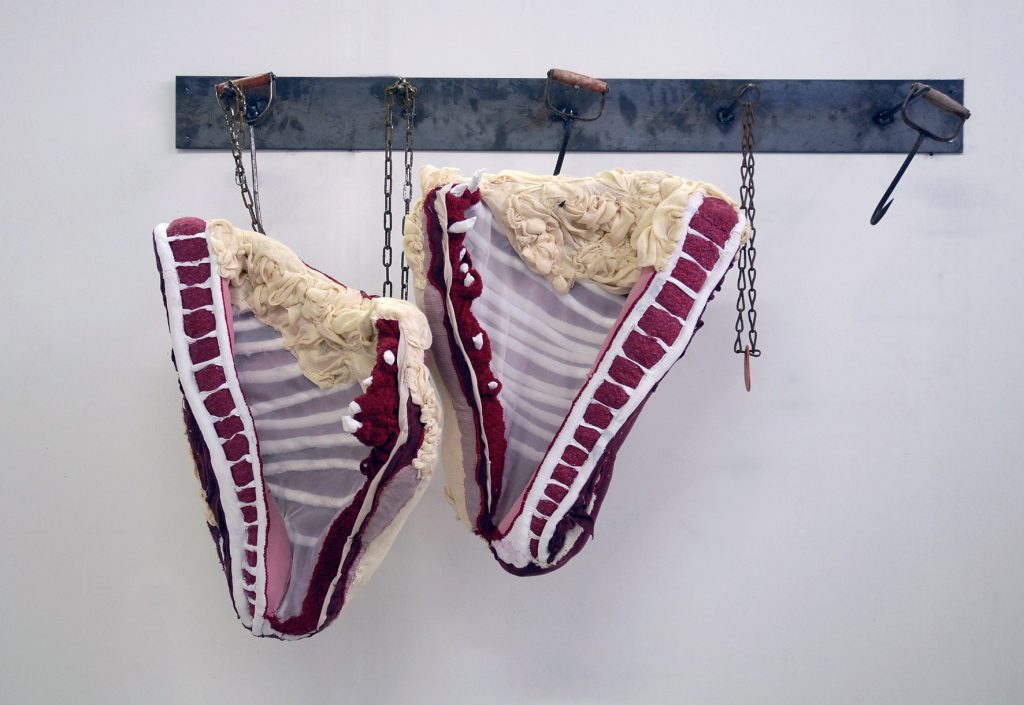
TAMARA KOSTIANOVSKY | ACTUS REUS
June 17, 2022Tamara Kostianovsky | Actus Reus
I am afraid the good woman did not realize how difficult it is to cut up a body, never having done so herself. (Margaret Atwood, Alias Grace)
To the Puritan all things are impure, as somebody says. (D.H. Lawrence, Sketches of Etruscan Places)
Tamara Kostianovsky’s artworks are disquieting; that is meant as praise. What her sculptures in the body of work titled Actus Reus – both specific elements and the larger installations of multiple components – do is allude, and we do the rest. What we initially ‘think’ we’re looking at is not at all what we’re truly observing. An initial revulsion turns to seduction, and we find ourselves drawn in by both the formal attraction as well as the conceptual fracture that only makes her work more enticing.
It’s almost appropriate, then, that one of the works that comprises Actus Reus is titled Abnegation (which means “the act of renouncing or rejecting something”); or that the name of the series itself is a ‘criminal’ legal term. Actus Reus is “sometimes called the external element or the objective element of a crime….the Latin term for the “guilty act” which, when proved beyond a reasonable doubt in combination with the mens rea, “guilty mind”, produces criminal liability in the common law−based criminal law jurisdictions of numerous countries….” There is almost a culpability in our own interactions with these artworks…..
Other works in this series – What It Once Was (2011), One and a Half (2008), Bound (2008), Venus (2011), Elegy (2009) – all leave the viewer feeling as though they’re looking upon – and enjoying gazing upon, devouring with their eyes – something that is forbidden, not meant to be seen, and definitely not be enjoyed, as though illicitly consuming visual pleasure from them….
Before I delve further into my interpretations of Kostianovsky’s work, her statement is as follows: The discovery of a world concealed behind the skin took form in my adolescence while working at a surgeon’s office, where veins exploded into waterfalls, cut ligaments set free the muscles they once contained, and chunks of fat poured over tissues of various colors and textures. A fascination with these encounters put the body at the center of my work, allowing me to use this imagery to reflect on consumption, ecology, and the voracious needs of the body.
Read more of Bart Gazzola’s thoughts on this work here.
Read More
Recent Comments